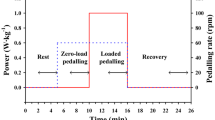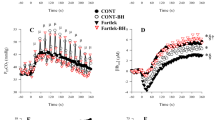Abstract
The purpose of this study was to determine the effect of sampling strategy (i.e., number of breaths) on measured peak rate of oxygen uptake (V̇O2peak) elicited by a range of severe intensity exercise bouts. The hypothesis was that a smaller sample (i.e., fewer breaths) would produce a higher measure of V̇O2peak and that this effect would be greater in shorter tests than in longer tests. Thirty-three university students performed constant-power cycle ergometer tests at intensities selected to elicit fatigue in ~3.0 min (short duration), ~5.5 min (medium duration), and ~8.0 min (long duration). Values for V̇O2peak were the highest rates of oxygen uptake obtained using the following sampling methods: single breath, and 3-, 5-, 15- and 30-breath rolling averages. As hypothesized, measures of V̇O2peak increased systematically with decreasing sample size. Contrary to the hypothesis, the effect of sample size was greater in medium duration and long duration tests than in the short duration tests. The interaction between test duration and sample size on measures of V̇O2peak highlights the importance of standardizing the analysis protocol for exercise in the severe domain. If such standardization is not feasible, it should be recognized that specific analysis protocols may exert a substantial effect upon the reported V̇O2peak.


Similar content being viewed by others
References
Beaver WL, Lamarra N, Wasserman K (1981) Breath-by-breath measurement of true alveolar gas exchange. J Appl Physiol 51:1662–1675
Craig IS, Morgan DW (1998) Relationship between 800-m running performance and accumulated oxygen deficit in middle-distance runners. Med Sci Sports Exerc 30:1631–1636
Di Prampero PE, Lafortuna CL (1989) Breath-by-breath estimate of alveolar gas transfer variability in man at rest and during exercise. J Physiol (Lond) 415:459–475
Gaesser GA, Poole DC (1996) The slow component of oxygen uptake kinetics in humans. In: Holloszy JO (ed) Exercise and sport sciences reviews. Williams and Wilkins, Baltimore, Md., pp. 35–70
Geppert J, Zuntz N (1888) Ueber die Regulation der Athmung. Pflugers Arch 42:189–245
Hill DW, Smith JC (1999) Determination of critical power by pulmonary gas exchange. Can J Appl Physiol 24:74–86
Hill DW, Poole DC, Smith JC (2002) The relationship between power and the time to achieve V̇O2max. Med Sci Sports Exerc 34:709–714
Hlastala MP, Wranne B, Lenfant CJ (1973) Cyclical variations in FRC and other respiratory variables in resting man. J Appl Physiol 34:670–676
Hughson RL, Green HJ (1982) Blood acid-base and lactate relationships studied by ramp work tests. Med Sci Sports Exerc 14:297–302
Johnson JS, Carlson JJ, VanderLaan RL, Langholz DE (1998) Effects of sampling interval on peak oxygen consumption in patients evaluated for heart transplantation. Chest 113:816–819
Linnarsson D (1974) Dynamics of pulmonary gas exchange and heart rate changes at start and end of exercise. Acta Physiol Scand Suppl 415:1–68
Matthews JI, Bush BA, Morales FM (1987) Microprocessor exercise physiology systems vs a nonautomated system. Chest 92:696–703
Myers J, Walsh D, Sullivan M, Froelicher V (1990) Effect of sampling on variability and plateau in oxygen uptake. J. Appl Physiol 68:404–410
Otis AB (1968) Quantitative relationships in steady-state gas exchange. In: Respiration. Handbook of physiology, vol 1. American Physiological Society, Washington, D.C., pp. 681–698
Pearce DH, Milhorn HT (1977) Dynamic and steady-state respiratory responses to bicycle ergometer exercise. J Appl Physiol 42:959–967
Poole DC, Whipp BJ (1988) The 'Haldane transformation' predates Haldane. Med Sci Sports Exerc 20:420–421
Poole DC, Ward SA, Gardner G, Whipp BJ (1988) A metabolic and respiratory profile of the upper limit for prolonged exercise in man. Ergonomics 31:1265–1279
Roston WL, Whipp BJ, Davis JA, Cunningham DA, Effros RM, Wasserman K (1987) Oxygen uptake kinetics and lactate concentration during exercise in humans. Am Rev Respir Dis 135:1080–1084
Sloniger MA, Cureton KJ, Carrasco DI, Prior BM, Rowe DA, Thompson RW (1996) Effect of the slow-component rise in oxygen uptake on V̇O2max. Med Sci Sports Exerc 28:72–78
Sullivan M, Genter F, Savvides M, Roberts M, Myers J, Froelicher VF (1984) The reproducibility of hemodynamic, electrocardiographic, and gas exchange data during treadmill exercise in patients with stable angina pectoris. Chest 86:375–382
Whipp BJ (1994) The slow component of O2 uptake kinetics during heavy exercise. Med Sci Sports Exerc 26:1319–1326
Whipp BJ, Mahler M (1980) Dynamics of pulmonary gas exchange during exercise. In: Pulmonary gas exchange, vol II. Academic, New York, pp 33–96
Whipp BJ, Ward SA, Lamarra N, Davis JA, Wasserman K (1982) Parameters of ventilatory and gas exchange dynamics during exercise. J Appl Physiol 52:1506–1513
Author information
Authors and Affiliations
Corresponding author
Rights and permissions
About this article
Cite this article
Hill, D.W., Stephens, L.P., Blumoff-Ross, S.A. et al. Effect of sampling strategy on measures of V̇O2peak obtained using commercial breath-by-breath systems. Eur J Appl Physiol 89, 564–569 (2003). https://doi.org/10.1007/s00421-003-0843-1
Accepted:
Published:
Issue Date:
DOI: https://doi.org/10.1007/s00421-003-0843-1




